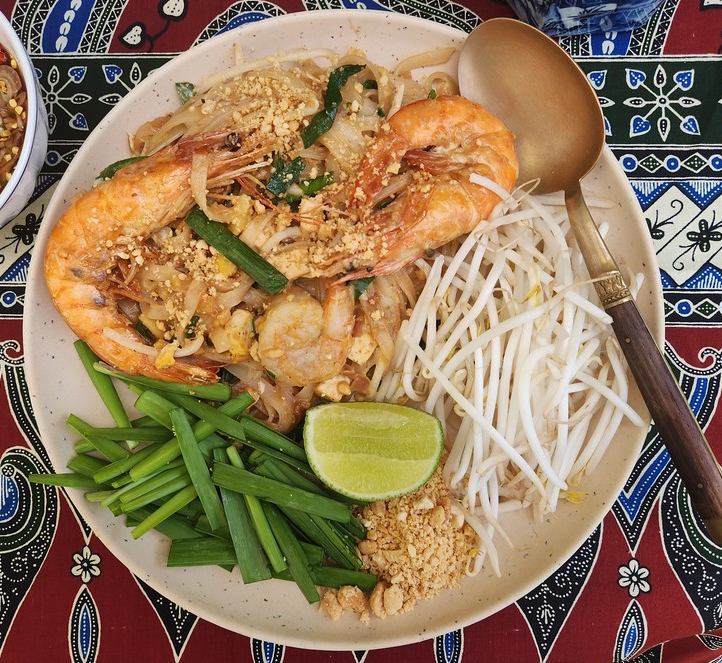
Chemmeen Curry hails from one of the most naturally beautiful, historically interesting, and culturally diverse places in the world. The recipe calls for shrimp, but a firm white fish could be substituted, and tofu might work just fine if you are a vegetarian.
In the country of India, the state of Kerala is known as "God's Own Country," due to it's stunning natural environment with tropical rain forests and a beautiful coastline. My family was incredibly fortunate to visit there in 2012, and we learned that Kerala has a lot more going for it than natural splendor (although it indeed has that). We stayed in Fort Cochin, which is Kerala's ancient port city that has been a spice trade entrepot for quite literally thousands of years. Kerala is one of the most culturally diverse places in India (and that is saying something!). There you will find Hindus, Muslims, and Christians living in relative harmony compared to other more troubled areas in India. When we got to Kerala, the first thing we noticed was that we'd arrived just before state elections. Looking rather out of place (at least to us, certainly not the people who live there) was an abundance of bright red banners and large posters with images of Karl Marx, Vladimir Lenin and Che Guevara. Power routinely fluctuates between a more left leaning than typical Indian National Congress and a less radical version of the Communist Party of India.
Fort Cochin is home to the Paradesi Synagogue, originally built in 1568 and making it the oldest synagogue still in existence in Asia. The original Jewish inhabitants may have arrived in Southern India following the destruction of the "Firs Temple" in 587 B.C,. and there is documentary evidence that more came after the destruction of the Second Temple in 70 CE. By one accounting, as many as 10,000 arrived in what is now known as Cochin. Still more settled some time in the 12th Century, and they are referred to as the Malibari Jews or the Black Jews. At the height of their community, they had build seven synagogues in Cochin. In the 16th Century, Ladino speaking Sephardic Jews arrived and established themselves, becoming known at the Paradesi (foreign) or White Jews. Still later in late 19th Century, Arabic speaking Jews also came to Kerala and were called Baghdadi Jews. These latter groups worshipped at the Paradesi Synagogue. Relations between the Jewish community and local leaders was complex, but mostly amicable; but the relations with conquering European powers (the Dutch and Portuguese) were far more tumultuous. With the founding of Israel, most of the Jewish population of Kerala emigrated to Israel. The young woman, Yaheh Hallegua, who sells tickets to tourists at the synagogue is one of the last remaining Paradesi Jews in the city.
Kerala is also one of (if not the only) surviving communities of a branch of Catholicism that once spanned all of southern continental Asia. They are variously know as St. Thomas, or Syrian, Nasrani, or Malabar Catholic Church. This branch of Catholicism was thought to have been founded by St. Thomas the Apostle in the mid part of the first century. It is believed that he established seven churches in Kerala. They are sometimes referred to as Syrian Catholics because of their close coordination with the Syrian Church between 496 to 1599 CE, although culturally they were far more Indian than not and rather independent in spirit. Nowadays they are referred to as the Syro Malabar Church. They more than three million strong in Kerala, and there are more than 200,000 living outside of India, the largest group being the 85,000 that live in Chicago, USA. All told, there are over 3,000 parishes world-wide.
One of the best things to do in Fort Cochin, is to visit the "Go Downs," the spice warehouse along the edges of the city's harbor. There you will find workers using ancient techniques for processing spices, along with merchants making deals on their iphones. There seems to be a nearly infinite number of different spices being loaded and off-loaded from boats and ships, on display for buyers and being processed by hand and machine. The aromas are overwhelming (in a very nice way). Other warehouses ship rice, and again there are a great number of varieties being sold and shipped.
Other highlights include taking in a performance of the elaborately costumed Kathakali dance dramas, where donning of costumes and putting on makeup are integrated into the ritual. The Kathakali drama consists of stories from the Hindu scriptural epics, the Mahabarata and the Ramayana. It's a tradition that dates back at least 1500 years and was originally a part of the cult of Bhagavathy temple festivals. Now performances are mostly done for tourists visiting Kerala. Some (all?) of the actors place a seed from the African Eggplant or Chandra Flower under their eyelids which turns the whites of their eyes blood red. Very Dramatic indeed!<
One of the sites to see (which are also a tourist fixture in Fort Cochin) are the 30-foot tall Chinese cantilevered fishing nets, which are rather photogenic. Although they are called the Chinese Fishing Nets, their actual history is only speculative. It is said that if you find the right one, the operators will snag a fish or two, which can be then taken to a local eatery to be cooked.
Another favorite pastime for tourists in Kerala are the houseboat cruises through the backwaters of Alleypy (south of Cochin). These houseboats are unlike anything you have ever seen. Originally used to transport rice and produce (the local name for them is Kettuvalloms), these are for all intents and purposes floating luxury suites that exuberantly embrace a tropical fantasy style. The boats move slowly through palm-tree and rice-field surrounded waters, and you can even rent ones that are "punted," moved along tranquil waters propelled by human powered poles.
And oh yes, the food in Kerala is wonderful. Although most of the cuisine is vegetarian, there are also many meat and poultry dishes to be enjoyed. Due to proximity to the ocean, fish is also widely consumed. Coconut palms abound in the Southwest of India, so this is a very important ingredient in cooking. Rice and cassava (tapioca) are the major starches consumed. Also known as the "Land of Spices," many dishes are highly spiced and tamarind is used freely to add a touch of sour to dishes. Chilies are also used in abundance. Not surprisingly, foods and food avoidances differ according to whether a household is Hindu, Muslim or Christian. Food is traditionally served on banana leaves. Kerala is also known for a banquet style of eating called sadya, a feast enjoyed on special occasions, featuring rice and a great number of vegetarian side dishes.
Our recipe of the month is Chemmeen Curry, otherwise known as Kerala Prawn Kerala Shrimp Curry. Whether you used prawns (generally from fresh water, bigger and having 3 pairs of claws) or shrimp (from saltwater, generally smaller and having only 2 sets of claws) doesn't matter one bit. To go along with the curry, we have a recipe for appam, a coconut and rice batter pancake that hails from Kerala. It goes great with any meal of the day, but is often eaten with fish curry for breakfast. Appam gets its slight rise from fermenting the rice for a day before cooking. Store bought mixes use baking soda to achieve rise. Appam is believed to have originated in Kerala, but many different forms of the idea are found throughout southern India. Appam is particularly associated with the St. Thomas Catholics, but the food historian and cookbook author Gil Marks says that appam was also a favorite of the Jewish community in Kerala.
he recipe requires a technique widely used in Indian cooking called "tadka" or "spluttering" or "tempering," the frying/roasting of spices and other ingredients in hot Ghee (clarified butter), adding them to a dish either in the beginning or end of the preparation. Tempering brings out the full taste and aroma of many spices. The trick is to add the spices and ingredients in the right order and watch them very carefully so that they don't burn. Fortunately tempering takes mere seconds. If you do burn the spices, throw them away and try again until you get it right. Remember the process takes mere seconds, so do-overs are perfectly ok!
Typically this dish is prepared in an clay cooking pot, but this is not absolutely required. There are some regional variations such as adding green mangoes or tomatoes to the dish while cooking. If you want a thicker curry, use coconut cream; otherwise use coconut milk. You can adjust the spices to your own preferences, as it's always fun to experiment! All the specialty ingredients can be purchased in an Indian grocery store like Cash and Carry on Miramar road.
Ingredients:
- 1 pound of medium size shrimp or prawns
- 1 tablespoon finely grated fresh ginger
- 1 teaspoon crushed garlic
- 1 teaspoon ground coriander
- 1 teaspoon Garam Masala
- 2 teaspoons turmeric powder
- 1 teaspoon chili powder
- 5-6 curry leaves
- 1 teaspoon black mustard seeds
- 1/2 teaspoon fenugreek (methi) seeds
- 1 tablespoon tamarind pulp or 1 teaspoon tamarind concentrate
- 2 cups coconut milk or cream
- 3 red chilies split lengthwise
- 3 green chilies split lengthwise
- 8 shallots
- 1 tablespoon ghee
- 1 teaspoon salt (optional)
Preparation:
- Clean and de-vein the shrimp.
- In a medium sized pot, heat the ghee until it is very hot.
- Add mustard and fenugreek seeds until they sputter.
- Add shallots, ginger, garlic, chilies, curry leaves, and saute until fragrant.
- Add ground coriander, garam masala, chili powder, turmeric and cook 1 minute longer.
- Stir in coconut milk/cream and tamarind.
- Bring to a boil and then turn down to a simmer.
- Add shrimp and simmer just long enough for the shrimp to cook through (about 2 minutes).
- Serve with appam or rice.
Appam (Kerala Rice Pancakes)
Ingredients:
- 1 cup of appam rice
- 1/2 cup of finely shredded unsweetened coconut
- 2 tablespoons of Yeast
- 2 cups of Water
Preparation:
- Soak the rice in 2 cups of water for 1 hour.
- Drain rice after it has been soaked
- Add rice, coconut and sugar to a food processor and blend it to a fine paste.
- Add enough warm water (80oF.)to make a thin batter.
- Mix in the yeast.
- Store batter in a warm place (80oF.) for 8 hours or overnight.
- Heat a non-stick small skillet (6") to medium high and very lightly coat with some cooking oil (coconut oil is best).
- Ladle about a quarter cup of the batter into the pan.
- Swirl the batter in the pan so that it covers not only the bottom of the pan, but an inch or so up the side of the pan (this is what creates the lacy border).
- Cover the pan.
- Fry the appam until the edges are light brown.
Additional notes:
- You can use appam premixed powder, which also includes lentils.
- If you use a premix, omit the sugar, but still add the yeast and wait until the batter ferments.
- You can use coconut milk instead of the shredded coconut and water for either method of preparation.
- Appam uses a particular variety of rice (known as appam rice), but any white rice would probably work fine.
Recipe: T. Johnston-O'Neill
Photo: Kathleen Johnston









